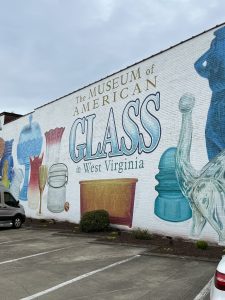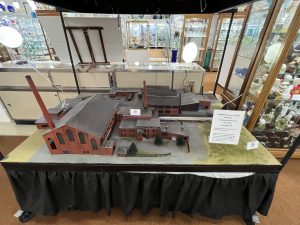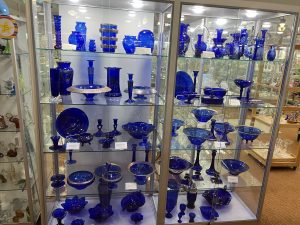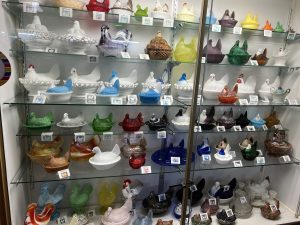 I’ve seen the colorful mural for The Museum of American Glass in Weston dozens of times and I always wondered what was inside the huge building on Main Street. When I looked through the windows, it seemed like it might be a glorified flea market and I never took the time to go inside. On a recent trip to Weston, we were a little early for our dinner at the Thyme Bistro, so we decided to stop by the museum. As we entered, the young lady at the desk said that they were closing in a few minutes but to feel free to take a quick tour of the facility. As we walked through the display cases, we were so impressed at this local attraction, just a short drive from Clarksburg.
I’ve seen the colorful mural for The Museum of American Glass in Weston dozens of times and I always wondered what was inside the huge building on Main Street. When I looked through the windows, it seemed like it might be a glorified flea market and I never took the time to go inside. On a recent trip to Weston, we were a little early for our dinner at the Thyme Bistro, so we decided to stop by the museum. As we entered, the young lady at the desk said that they were closing in a few minutes but to feel free to take a quick tour of the facility. As we walked through the display cases, we were so impressed at this local attraction, just a short drive from Clarksburg.
The Museum of American Glass in Weston was established in 1993 as a nonprofit with a goal to discover, publish and preserve whatever may relate to the glass industry in West Virginia, the United States of America or wherever else glass has been manufactured. It is probably one of the nicest tributes to the glass industry and it is in one of the richest regions for glass making in America. From the time I was a small boy, I can remember people talking about the McNicol China factory and the glass plants in the Adamston neighborhood and North View neighborhood in Clarksburg. The tall brick smokestacks dotted the landscapes throughout Central West Virginia and

many of my relatives worked at the Hazel-Atlas factory, later to become Continental Can and finally Anchor Hocking.
The museum captures the variety of glass and there is even a small rendition of a glass factory. I remember my mother having a small glass candy dish in the shape of a hen. It was an amber color and she had it for most of my life. The display at the museum had dozens of these glass dishes in every color and size. A quick search on Google indicates that these dishes that probably sold for a dollar or two are now selling for around $40 apiece. These were only one style of glassware on display and I’m sure a visit would bring back memories of long ago for many visitors.
It is hard to imagine what an impact the glass industry

has had on thousands of families in our area. Many people spent their entire careers working in the factories and stories about the “hot end” or the “decorating” department can elicit hours of anecdotes from men and women who worked in the factories. Before plastic and Styrofoam, glass was used for beer and soda bottles, as well as dishes and cooking bowls and thousands of other uses. Even insulators that were on every electric pole were made of glass. Many years ago, when McDonald’s restaurants needed a giveaway, they would give away colorful glasses, in the hundreds of thousands, manufactured right here in the Anchor Hocking factory.
Surprisingly, the admission to the museum is free and you

would gladly pay several dollars to see the variety of exhibits and the sheer number of pieces. If you have elderly relatives, this would be a great place for a day trip, and I am sure this would put a smile on their faces. I plan to take my granddaughters to the museum when they visit from South Carolina this summer. Like many places I write about, this is a jewel, just waiting to be discovered. Give it a try and I’m sure you will be impressed with this Amazing museum.


